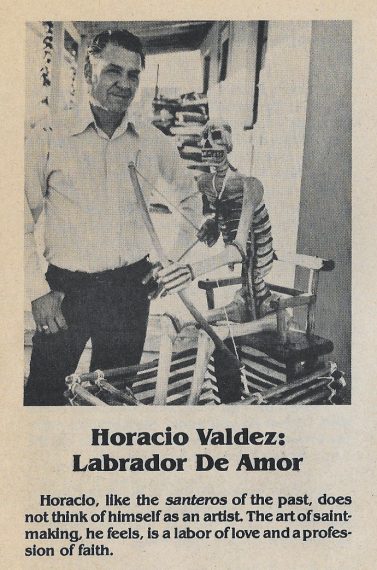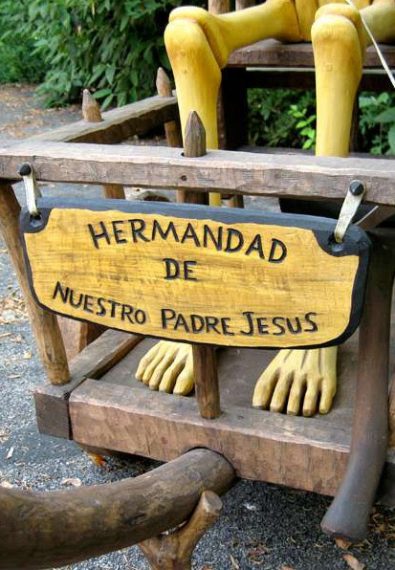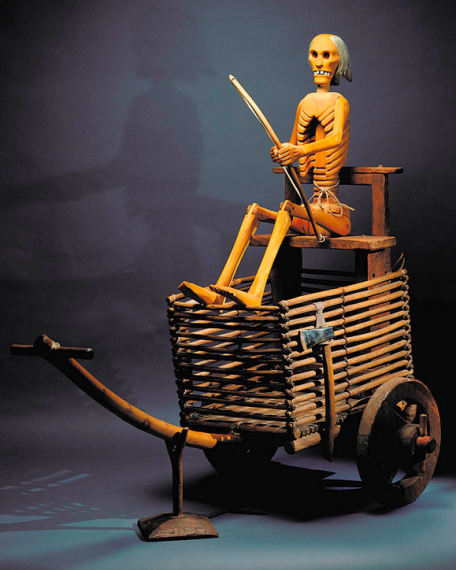A significant museum work of art from Galerie Bonheur Collection will be auctioned in New Mexico
by Laurie Ahner
The “Death Cart” – special work of art by Horacio Valdez, a famous Santero from New Mexico – has traveled the world in museum settings and major art exhibits and it now needs to have a permanent home, to be appreciated and admired by an art- loving public!
HORACIO VALDEZ
L A M U E R T E
D E A T H C A R T

Photo: Copyright © Santa Fe Art Auction, 2017
Horacio Valdez
(1929-1992, New Mexico),
La Muerte Death Cart, 1983.
Polychrome carved wood, 53 x 50 x 32 inches.Available on November 11, 2017
at Santa Fe Art AuctionView This Artwork at the Santa Fe Art Auction Website HereFor inquiry:
Laurie Ahner, Director & Owner
info@galeriebonheur.com or 314.409.6057
(1929-1992, New Mexico),
La Muerte Death Cart, 1983.
Polychrome carved wood, 53 x 50 x 32 inches.Available on November 11, 2017
at Santa Fe Art AuctionView This Artwork at the Santa Fe Art Auction Website HereFor inquiry:
Laurie Ahner, Director & Owner
info@galeriebonheur.com or 314.409.6057


A B O U T T H E A R T I S T
Horacio Valdez (1929 – 1992), a carpenter by trade, became a santero (a creator of religious images, literally “maker of saints”) in 1975 after sustaining a near fatal injury at the Nambe Dam project where he was employed. Valdez crushed his right hand in the accident and could not return to work. “I couldn’t hold a hammer,” he said, “but I could whittle.” Thus began Valdez’s prolific career as a wood carver in New Mexico, where he is noted for his influence in re-energizing traditional religious imagery. (image below: Horacio Valdez at the completion of his work La Muerte Death Cart, at his home in New Mexico, copyright © Galerie Bonheur)

Valdez is best known for his Penitente-inspired death carts. These large scale sculptures depict a female skeletal image riding atop a miniature wooden ox cart. The skeleton, called La Muerte (Death) or Dona Sebastiana, usually carries a hatchet, bow and arrow, or other instrument of death. The figure is a reminder of human mortality or memento mori. Real death carts appear during Holy Week when members of the Brotherhood of the Penitentes, or “Hermandad de Nuestro Padres Jesus Nazareno,” reenact the suffering and crucifixion of Christ by pulling carts filled with stones in a procession as penance. (image below: Feria Artesana, The Albuquerque Museum, 1981, “Horacio Valdez: Labrador De Amor”)

The “La Muerte” Death Cart was commissioned by Galerie Bonheur directly from Horacio Valdez at his home in Dixon, New Mexico. The sculpture took approximately 8 months to complete, and Galerie Bonheur has maintained ownership of the piece since its creation in 1983. The death cart was on loan from October 5, 1986 to May 29, 1988 in a traveling exhibit entitled “Beyond Tradition: Contemporary American Folk Art.” This exhibit, organized by the Katonah Gallery (now the Katonah Museum of Art), traveled both throughout the United States and Europe. (image below: detail: Horacio Valdez, La Muerte Death Cart, 1983, Galerie Bonheur)

Other Valdez carvings have been shown at the Museum of American Folk Art, the Museum of International Folk Art in Santa Fe, the Taylor Museum in Colorado Springs, and the Albuquerque Museum. Another death cart, entitled “Carreta de Muerte” (1975) resides in the permanent collection of the Smithsonian American Art Museum. (image below: Horacio Valdez, Carreta de Muerte, 1975, Smithsonian American Museum)
